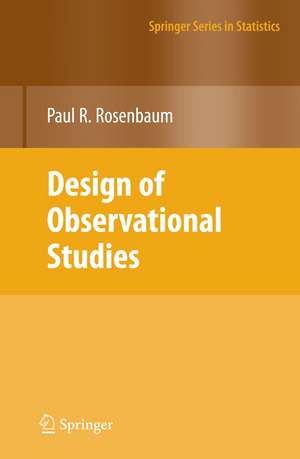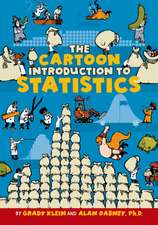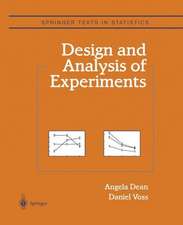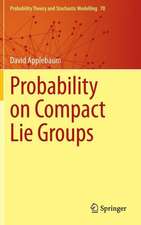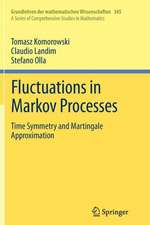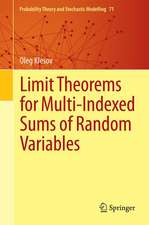Design of Observational Studies: Springer Series in Statistics
Autor Paul R. Rosenbaumen Limba Engleză Paperback – 25 feb 2012
Design of Observational Studies is divided into four parts. Chapters 2, 3, and 5 of Part I cover concisely, in about one hundred pages, many of the ideas discussed in Rosenbaum’s Observational Studies (also published by Springer) but in a less technical fashion. Part II discusses the practical aspects of using propensity scores and other tools to create a matched comparison that balances many covariates. Part II includes a chapter on matching in R. In Part III, the concept of design sensitivity is used to appraise the relative ability of competing designs to distinguish treatment effects from biases due to unmeasured covariates. Part IV discusses planning the analysis of an observational study, with particular reference to Sir Ronald Fisher’s striking advice for observational studies, "make your theories elaborate."
The second edition of his book, Observational Studies, was published by Springer in 2002.
| Toate formatele și edițiile | Preț | Express |
|---|---|---|
| Paperback (2) | 731.73 lei 43-57 zile | |
| Springer – 25 feb 2012 | 731.73 lei 43-57 zile | |
| Springer International Publishing – 14 iul 2021 | 957.62 lei 43-57 zile | |
| Hardback (1) | 963.91 lei 43-57 zile | |
| Springer International Publishing – 14 iul 2020 | 963.91 lei 43-57 zile |
Din seria Springer Series in Statistics
- 14%
 Preț: 679.60 lei
Preț: 679.60 lei - 20%
 Preț: 630.97 lei
Preț: 630.97 lei - 20%
 Preț: 816.43 lei
Preț: 816.43 lei - 20%
 Preț: 1000.84 lei
Preț: 1000.84 lei -
 Preț: 390.84 lei
Preț: 390.84 lei - 20%
 Preț: 697.13 lei
Preț: 697.13 lei - 20%
 Preț: 445.20 lei
Preț: 445.20 lei - 20%
 Preț: 881.51 lei
Preț: 881.51 lei - 18%
 Preț: 1237.14 lei
Preț: 1237.14 lei - 18%
 Preț: 967.22 lei
Preț: 967.22 lei - 18%
 Preț: 956.50 lei
Preț: 956.50 lei - 18%
 Preț: 794.25 lei
Preț: 794.25 lei - 15%
 Preț: 648.05 lei
Preț: 648.05 lei - 18%
 Preț: 1222.49 lei
Preț: 1222.49 lei - 15%
 Preț: 646.11 lei
Preț: 646.11 lei - 15%
 Preț: 647.08 lei
Preț: 647.08 lei - 15%
 Preț: 646.11 lei
Preț: 646.11 lei - 18%
 Preț: 1389.62 lei
Preț: 1389.62 lei - 15%
 Preț: 652.81 lei
Preț: 652.81 lei - 18%
 Preț: 1114.52 lei
Preț: 1114.52 lei - 18%
 Preț: 952.40 lei
Preț: 952.40 lei - 18%
 Preț: 1393.27 lei
Preț: 1393.27 lei - 18%
 Preț: 1561.68 lei
Preț: 1561.68 lei - 18%
 Preț: 1231.47 lei
Preț: 1231.47 lei - 15%
 Preț: 513.64 lei
Preț: 513.64 lei - 18%
 Preț: 893.71 lei
Preț: 893.71 lei - 15%
 Preț: 649.87 lei
Preț: 649.87 lei - 18%
 Preț: 1007.65 lei
Preț: 1007.65 lei - 18%
 Preț: 1111.67 lei
Preț: 1111.67 lei - 18%
 Preț: 1229.10 lei
Preț: 1229.10 lei - 18%
 Preț: 892.74 lei
Preț: 892.74 lei - 18%
 Preț: 913.26 lei
Preț: 913.26 lei - 18%
 Preț: 943.88 lei
Preț: 943.88 lei -
 Preț: 391.61 lei
Preț: 391.61 lei -
 Preț: 391.22 lei
Preț: 391.22 lei - 18%
 Preț: 1391.04 lei
Preț: 1391.04 lei -
 Preț: 390.84 lei
Preț: 390.84 lei - 18%
 Preț: 893.84 lei
Preț: 893.84 lei - 18%
 Preț: 960.61 lei
Preț: 960.61 lei - 18%
 Preț: 1245.34 lei
Preț: 1245.34 lei - 18%
 Preț: 964.54 lei
Preț: 964.54 lei - 15%
 Preț: 643.16 lei
Preț: 643.16 lei - 18%
 Preț: 1674.70 lei
Preț: 1674.70 lei - 15%
 Preț: 643.84 lei
Preț: 643.84 lei - 15%
 Preț: 586.37 lei
Preț: 586.37 lei - 18%
 Preț: 1004.99 lei
Preț: 1004.99 lei - 15%
 Preț: 643.34 lei
Preț: 643.34 lei - 18%
 Preț: 806.40 lei
Preț: 806.40 lei - 18%
 Preț: 727.66 lei
Preț: 727.66 lei
Preț: 731.73 lei
Preț vechi: 892.35 lei
-18% Nou
Puncte Express: 1098
Preț estimativ în valută:
140.02€ • 146.56$ • 116.54£
140.02€ • 146.56$ • 116.54£
Carte tipărită la comandă
Livrare economică 31 martie-14 aprilie
Preluare comenzi: 021 569.72.76
Specificații
ISBN-13: 9781461424864
ISBN-10: 1461424860
Pagini: 404
Ilustrații: XVIII, 384 p.
Dimensiuni: 155 x 235 x 21 mm
Greutate: 0.56 kg
Ediția:2010
Editura: Springer
Colecția Springer
Seria Springer Series in Statistics
Locul publicării:New York, NY, United States
ISBN-10: 1461424860
Pagini: 404
Ilustrații: XVIII, 384 p.
Dimensiuni: 155 x 235 x 21 mm
Greutate: 0.56 kg
Ediția:2010
Editura: Springer
Colecția Springer
Seria Springer Series in Statistics
Locul publicării:New York, NY, United States
Public țintă
ResearchCuprins
Beginnings.- Dilemmas and Craftsmanship.- Causal Inference in Randomized Experiments.- Two Simple Models for Observational Studies.- Competing Theories Structure Design.- Opportunities, Devices, and Instruments.- Transparency.- Matching.- A Matched Observational Study.- Basic Tools of Multivariate Matching.- Various Practical Issues in Matching.- Fine Balance.- Matching Without Groups.- Risk-Set Matching.- Matching in R.- Design Sensitivity.- The Power of a Sensitivity Analysis and Its Limit.- Heterogeneity and Causality.- Uncommon but Dramatic Responses to Treatment.- Anticipated Patterns of Response.- Planning Analysis.- After Matching, Before Analysis.- Planning the Analysis.
Recenzii
From the book reviews:
“The book is both a pragmatic how-to manual and a delightfully written manifesto. … The book contains four parts. … People very new to statistics could read this book quite readily, with the caveat that mathematical notation, language, and prose is used far more than in most classic introductory statistics books. This book seems most useful for statisticians and applied statisticians who are looking to learn about a new area that they might not have been exposed to before.” (Luke W. Miratrix, Psychometrika, Vol. 79, 2014)
“This is for those who want to improve whatever their basic design is—for those people, this is a very good book. … have several quick, but useful, guides: key elements in a design, solutions to common problems (very useful), a symbol glossary, a listing of acronyms, a glossary of statistical terms, suggested readings for a course on the design of observational studies, and an index. … anyone who is not an expert on the varietiesof matching will profit from reading this.” (Richard Goldstein, Technometrics, Vol. 53 (2), May, 2011)
Finally, the book covers all the relevant issues in designing and analyzing treatment effects in observational studies, with the exception of observer bias, i.e., the bias present when the assessment of the outcomes are not valid; see Haro et al. (2006) for further details. Nowadays, it is yet unusual to address hidden biases in observational studies and, therefore, this book is an essential reading for statisticians who want to go a step beyond from the likely naïve sentence: 'We assume no unmeasured confounding in the study’.” (Journal of Biopharmaceutical Statistics , 2011, Issue 1)
“Graduate students and researchers in statistics, biostatistics, econometrics, or academic researchers in statistically oriented fields of psychology and social sciences. … ‘Design of Observational Studies’ talks about statistics. … The book will be suitable for a seminar course for graduatestudents with previous knowledge of the subject area, or practicing statisticians seeking guidance in design of observational research and a language to discuss the issues. ‘Design of Observational Studies’ is an important book.” (Erkki P. Liski, International Statistical Review, Vol. 78 (1), 2010)
“The book is both a pragmatic how-to manual and a delightfully written manifesto. … The book contains four parts. … People very new to statistics could read this book quite readily, with the caveat that mathematical notation, language, and prose is used far more than in most classic introductory statistics books. This book seems most useful for statisticians and applied statisticians who are looking to learn about a new area that they might not have been exposed to before.” (Luke W. Miratrix, Psychometrika, Vol. 79, 2014)
“This is for those who want to improve whatever their basic design is—for those people, this is a very good book. … have several quick, but useful, guides: key elements in a design, solutions to common problems (very useful), a symbol glossary, a listing of acronyms, a glossary of statistical terms, suggested readings for a course on the design of observational studies, and an index. … anyone who is not an expert on the varietiesof matching will profit from reading this.” (Richard Goldstein, Technometrics, Vol. 53 (2), May, 2011)
Finally, the book covers all the relevant issues in designing and analyzing treatment effects in observational studies, with the exception of observer bias, i.e., the bias present when the assessment of the outcomes are not valid; see Haro et al. (2006) for further details. Nowadays, it is yet unusual to address hidden biases in observational studies and, therefore, this book is an essential reading for statisticians who want to go a step beyond from the likely naïve sentence: 'We assume no unmeasured confounding in the study’.” (Journal of Biopharmaceutical Statistics , 2011, Issue 1)
“Graduate students and researchers in statistics, biostatistics, econometrics, or academic researchers in statistically oriented fields of psychology and social sciences. … ‘Design of Observational Studies’ talks about statistics. … The book will be suitable for a seminar course for graduatestudents with previous knowledge of the subject area, or practicing statisticians seeking guidance in design of observational research and a language to discuss the issues. ‘Design of Observational Studies’ is an important book.” (Erkki P. Liski, International Statistical Review, Vol. 78 (1), 2010)
Textul de pe ultima copertă
An observational study is an empiric investigation of effects caused by treatments when randomized experimentation is unethical or infeasible. Observational studies are common in most fields that study the effects of treatments on people, including medicine, economics, epidemiology, education, psychology, political science and sociology. The quality and strength of evidence provided by an observational study is determined largely by its design. Design of Observational Studies is both an introduction to statistical inference in observational studies and a detailed discussion of the principles that guide the design of observational studies.
Design of Observational Studies is divided into four parts. Chapters 2, 3, and 5 of Part I cover concisely, in about one hundred pages, many of the ideas discussed in Rosenbaum’s Observational Studies (also published by Springer) but in a less technical fashion. Part II discusses the practical aspects of using propensity scores and other tools to create a matched comparison that balances many covariates. Part II includes a chapter on matching in R. In Part III, the concept of design sensitivity is used to appraise the relative ability of competing designs to distinguish treatment effects from biases due to unmeasured covariates. Part IV discusses planning the analysis of an observational study, with particular reference to Sir Ronald Fisher’s striking advice for observational studies, "make your theories elaborate."
Paul R. Rosenbaum is the Robert G. Putzel Professor of Statistics at the Wharton School of the University of Pennsylvania. He is a fellow of the American Statistical Association. In 2003, he received the George W. Snedecor Award from the Committee of Presidents of Statistical Societies. He is a senior fellow of the Leonard Davis Institute of Health Economics and a Research Associate at the Population Studies Center, both at the University of Pennsylvania. The second edition of his book, Observational Studies, was published by Springer in 2002.
Design of Observational Studies is divided into four parts. Chapters 2, 3, and 5 of Part I cover concisely, in about one hundred pages, many of the ideas discussed in Rosenbaum’s Observational Studies (also published by Springer) but in a less technical fashion. Part II discusses the practical aspects of using propensity scores and other tools to create a matched comparison that balances many covariates. Part II includes a chapter on matching in R. In Part III, the concept of design sensitivity is used to appraise the relative ability of competing designs to distinguish treatment effects from biases due to unmeasured covariates. Part IV discusses planning the analysis of an observational study, with particular reference to Sir Ronald Fisher’s striking advice for observational studies, "make your theories elaborate."
Paul R. Rosenbaum is the Robert G. Putzel Professor of Statistics at the Wharton School of the University of Pennsylvania. He is a fellow of the American Statistical Association. In 2003, he received the George W. Snedecor Award from the Committee of Presidents of Statistical Societies. He is a senior fellow of the Leonard Davis Institute of Health Economics and a Research Associate at the Population Studies Center, both at the University of Pennsylvania. The second edition of his book, Observational Studies, was published by Springer in 2002.
Caracteristici
The concepts of causal inference in experiments and observational studies are introduced using the elementary mathematics of independent coin flips to determine treatment assignment The basic tools of multivariate matching – such as propensity scores, optimal matching, full matching, fine balance, risk set matching – are introduced with many examples and with reference to implementation in R The key source of uncertainty in an observational study is possible bias from covariates that were not measured. The ability of competing designs to separate treatment effects from unmeasured biases – that is, the design sensitivity – is discussed in detail for the first time in book form Includes supplementary material: sn.pub/extras
Notă biografică
Paul R. Rosenbaum is the Robert G. Putzel Professor of Statistics at the Wharton School of the University of Pennsylvania. He is a fellow of the American Statistical Association. In 2019, he received the R. A. Fisher Award, and in 2003 the George W. Snedecor Award, both from the Committee of Presidents of Statistical Societies (COPSS). He is the author of Observation and Experiment: An Introduction to Causal Inference (2017) and Observational Studies, 2nd edition (Springer 2002).
